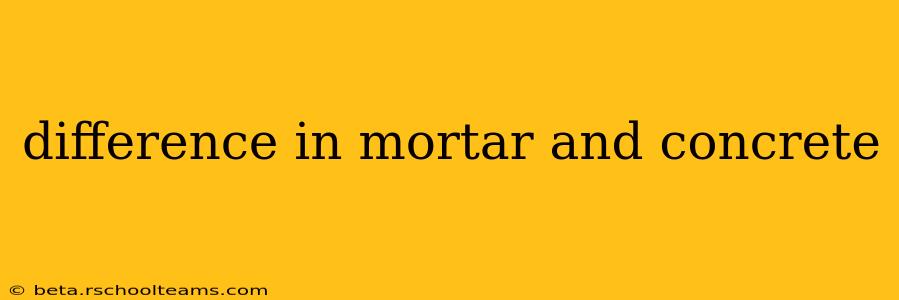The Key Differences Between Mortar and Concrete: A Comprehensive Guide
Mortar and concrete are both construction materials made from a mixture of cement, aggregates, and water. However, their compositions, applications, and properties differ significantly. Understanding these differences is crucial for anyone involved in building or construction projects. This guide will clarify the key distinctions and answer some frequently asked questions.
What is Mortar?
Mortar is a construction material used primarily to bind building blocks together, such as bricks, stones, and concrete blocks. It's a mixture of cement, fine aggregate (typically sand), and water. The key characteristic of mortar is its workability – it needs to be easily spread and shaped to fill the gaps between building blocks, creating a strong and durable bond. Mortar is generally less strong in compression than concrete.
What is Concrete?
Concrete is a composite material made of cement, aggregates (gravel, crushed stone, or recycled materials), and water. Unlike mortar, concrete uses a larger proportion of coarse aggregates, giving it significant strength in compression. Its primary function is to form structural elements like foundations, slabs, walls, and beams. Concrete's strength and durability make it the cornerstone of many modern structures.
What are the Key Differences Between Mortar and Concrete?
Here's a table summarizing the key differences:
| Feature | Mortar | Concrete |
|---|---|---|
| Aggregate | Primarily fine aggregate (sand) | Mixture of fine and coarse aggregates |
| Strength | Lower compressive strength | High compressive strength |
| Application | Binding building blocks | Structural elements |
| Workability | High, easily spread and shaped | Lower workability, requires specialized tools |
| Water-Cement Ratio | Relatively higher | Relatively lower |
| Typical Uses | Bricklaying, stonework, blockwork | Foundations, slabs, walls, beams |
What are the different types of mortar?
Mortar types are classified by their compressive strength and intended use. Different mixes of cement, lime, and sand create variations in properties like workability, water retention, and adhesion. For example, Type N mortar is general-purpose, while Type S is stronger and suitable for higher-strength applications. The exact specifications for different mortar types are available from standards organizations like ASTM International.
What are the different types of concrete?
Concrete also comes in many types, depending on the mix design, additives, and intended use. These include ready-mix concrete (pre-mixed at a plant), self-consolidating concrete (flows easily into complex forms), and high-strength concrete (used in high-performance structures). Specific concrete mixes are chosen based on factors like strength requirements, durability needs, and environmental conditions.
What is the difference in the strength of mortar vs concrete?
Concrete is significantly stronger in compression than mortar. This is due to the larger proportion of coarse aggregate in concrete, which contributes to its higher density and load-bearing capacity. While mortar provides sufficient strength for binding masonry units, it is not suitable for structural applications requiring high compressive strength.
Can I use concrete instead of mortar?
No, you should not use concrete instead of mortar for bricklaying or similar applications. Concrete's low workability makes it difficult to spread and fill the gaps between masonry units effectively. Furthermore, its high strength isn't necessary for this application, and it could even crack the bricks due to shrinkage. Using the correct material is crucial for ensuring structural integrity and longevity.
Can I use mortar instead of concrete?
No, you should not use mortar instead of concrete for structural elements like foundations or slabs. Mortar lacks the compressive strength necessary to support significant loads. Using mortar in place of concrete would compromise the structural integrity of the building, potentially leading to collapse or significant damage.
This comprehensive guide clarifies the differences between mortar and concrete. Remember, choosing the right material for the job is vital for successful construction projects. Always consult building codes and specifications to ensure compliance and safety.
